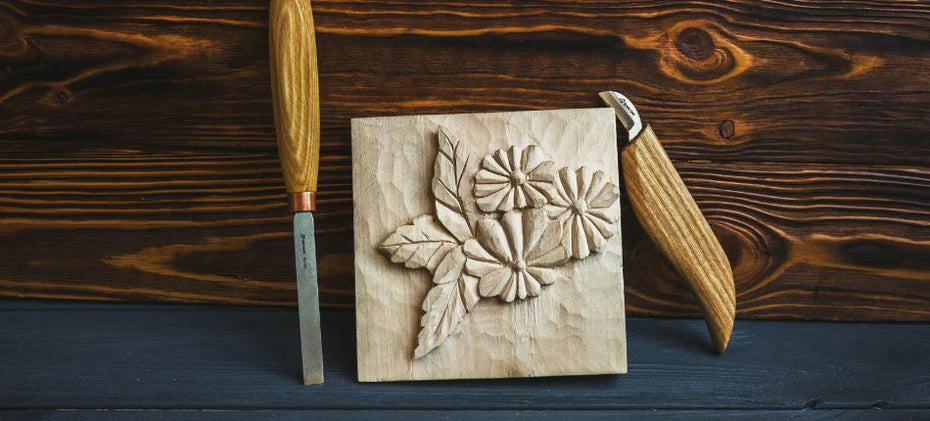Is Basswood Good for Carving?

In the fascinating and diverse world of wood carving, wood carvers of all skill levels are often faced with the question of which wood species is the best for their craft. And Basswood Wooden Blocks is a pretty popular choice among many options. But what is Basswood exactly, and why do carvers favor it? Let's dive into the world of Basswood, where we will explore the qualities of this exceptional wood and delve into its suitability for various projects and techniques, such as carving and whittling. We'll also discover why it has captured the hearts and imaginations of so many wood carving enthusiasts across the globe.
Best Basswood for Carving
If you are considering Basswood for carving, you should know that this wood has several varieties to choose from. Each type of Basswood possesses unique attributes and subtle differences that make it well-suited for specific carving styles and techniques. If you have an interest in exploring the fascinating world of wood, we highly recommend diving into our comprehensive article «Which Type of Wood is the Best for Beginners?»

American Basswood
Native to North America, American Basswood (Tilia americana) has long been cherished by woodcarvers for its exceptional qualities. It boasts a delightful pale hue, exuding a creamy elegance that adds a touch of refined beauty to any carving project. Its grain runs straight and true, providing an optimal canvas for carvers to bring their intricate detailing and delicate designs to life.
European Basswood
Also known as Lime Wood (Tilia europaea), European Basswood boasts a fine, even texture, making it a favorite among relief carvers. Its light color and great workability allow for intricate and expressive designs.
Japanese Basswood
Hailing from Japan, Japanese Basswood (Tilia japonica) possesses a slightly darker hue than its American and European counterparts. It is prized for its amazing carving properties, particularly for intricate relief carvings and decorative accents.
Carpathian Basswood
Carpathian Basswood (Tilia cordata) originates from the Carpathian Mountains in Eastern Europe. It is renowned for its uniform texture, softness, and light color, making it an exceptional choice for relief carvings and wood spirits. Don't miss out on our exclusive review of the softest woods, tailor-made for carving enthusiasts like yourself. If you have a passion for working with soft wood, this article is a must-read for you.
Argentine Basswood
Originating from the temperate forests of Argentina, Argentine Basswood (Tilia bonplandiana) is a sought-after wood for carving due to its distinct characteristics. This particular species showcases a delightful light cream color and features a minimal grain pattern. It has an exceptionally smooth surface, which allows for intricate and detailed work.
Each species has its distinct character and can influence the carving process and final results.
Is Basswood Hard to Carve?
One of the primary reasons woodcarvers cherish Basswood is its exceptional workability. But is Basswood good for carving? The resounding answer is yes! Unlike some hardwoods that can be challenging to carve, Basswood offers a favorable carving experience even for beginners. Its softness and fine grain contribute to its well-deserved reputation as a carving wood par excellence.

Advantages of Basswood Wood for Carving
Exploring basswood properties reveals a multitude of advantages that set it apart as a preferred option among woodcarvers and whittlers. Let's dive deeper into the qualities and characteristics of Basswood and uncover why it is held in such high regard.
- Softness. One of the primary advantages of Basswood lies in its renowned softness. This characteristic makes it exceptionally easy to carve and shape. Its forgiving nature allows for smooth and precise cuts, making it suitable for intricate detailing and achieving intricate designs.
- Fine Grain. The fine, uniform grain of Basswood enhances the level of detail that can be achieved in carving. This characteristic ensures clean and crisp lines, enabling carvers to bring out the desired intricacies in the final carved piece. To preserve and accentuate the captivating beauty of wood grain in your carving endeavors, we invite you to delve into our insightful article titled «How to Maintain Wood Grain?»
- Lack of Resins. Unlike some other wood species, Basswood contains minimal resins. This absence of resinous substances prevents the wood from interfering with the carving process, ensuring cleaner cuts and minimizing the risk of resin buildup on tools.
- Versatility. Basswood offers versatility in both carving and finishing. It readily accepts stains, paints, and finishes, allowing carvers to achieve their desired aesthetic outcomes. This versatility grants artisans the freedom to explore various decorative techniques and styles.
- Acceptance of Stains and Finishes. The open-pored structure of Basswood makes it highly receptive to stains and finishes. It absorbs these treatments exceptionally well, resulting in a smooth and even appearance. This attribute enables carvers to enhance the natural beauty of the wood or create unique colorations and effects.
- Availability. Accessibility is a significant advantage when it comes to this wood. You can find various options of basswood carving blocks or basswood blanks readily available on the market. Such availability and convenience make Basswood a preferred choice for beginners and experienced carvers seeking high-quality materials for their projects.

Downsides of Basswood Wood for Carving
As you can see, basswood properties make it a really good choice for carving, but it is important to remember that every wood species has its potential drawbacks, and Basswood is no exception.
- Vulnerability to Damage. Due to its softness, Basswood can be more exposed to dents and scratches than harder woods. Take care of your projects to protect finished carvings from accidental impacts or mishandling.
- Lack of Color and Grain Variation. While Basswood features a pale and uniform color ideal for some carving styles, it may not appeal to those seeking a more pronounced and vibrant wood grain or coloration. When choosing Basswood for a project, it is important to consider the desired aesthetic outcome.
- Susceptibility to Insect Infestation. Like many other wood species, Basswood is susceptible to insect infestations if stored or treated unproperly. Taking precautions such as proper seasoning and protecting finished carvings from pests is crucial to maintaining the integrity of the wood.
- Lack of Natural Resistance to Decay. Basswood does not possess inherent resistance to decay or moisture. When using Basswood for outdoor projects or functional carvings, additional protective measures, such as sealing or appropriate finishes, should be employed to prolong its lifespan.
Green Basswood Wood vs. Dry Basswood
Choosing between dry and green Basswood for carving, dry Basswood takes the lead. While green Basswood offers greater workability due to its higher moisture content, dry Basswood provides several advantages that make it the preferred option for many carvers.
Dry Basswood offers increased stability and predictability as it has gone through a seasoning process. It is less prone to warping, shrinking, or cracking, ensuring the final dimensions and shape of the carving remain intact.

Is Basswood Good for Whittling?
If you are wondering about the suitability of Basswood for whittling, rest assured that it is a great option for all kinds of whittling projects. Its softness and fine grain make it a preferred wood for whittlers of all skill levels. Whether it's crafting small figurines, utensils, or decorative items, Basswood's qualities make it an ideal companion for this wood carving technique.

Basswood Carving Projects
As one of the most suitable materials for carving, Basswood finds its place in a wide array of projects. And we've prepared a few examples where this wood type excels:
Whittled FiguresWhen it comes to creating beautiful whittled figures, Basswood reigns supreme. Its superior softness and fine grain make it the perfect choice for bringing these small wooden sculptures to life. This wood has a remarkable workability that allows for incorporating delicate details and smooth surfaces.
Relief CarvingsThe qualities of Basswood also make it highly sought after for relief carvings. With its fine and even texture, this wood species is a popular choice among carvers who specialize in this particular style. It offers ease in shaping, making it ideal for creating intricate details that truly stand out in relief carvings.

The versatility of Basswood makes it an ideal choice for crafting decorative ornaments of different designs and purposes. From intricate snowflakes and delicate flowers to ornate architectural details, the softness and fine grain of this wood allow for precise carving and a smooth, polished finish.
Wood Spirits and MasksThe smooth, knot-free surface of Basswood is great for carving wood spirits and masks. The softness of the wood helps to achieve flowing lines and intricate facial expressions, breathing life into such projects.

The light weight of Basswood and its carving properties make it a popular choice for crafting walking sticks and canes. Its softness allows for comfortable grip carving, while the fine grain ensures a smooth finish.
If you're wondering where to buy wood for whittling or carving needs, there are various options available. You can find Basswood carving blocks, including big sets and special pre-cut blanks, at specialized woodworking stores, both online and offline. These stores cater to the diverse needs of woodcarvers by offering a wide selection of materials in various quantities and sizes.
So, whether you prefer the convenience of online shopping or the hands-on experience of visiting a physical store, you can explore the wide array of options available to fuel your wood carving passion.
Author:

Roman Law
Wood carving guruFrom a childhood enchanted by nature, my passion for wood carving guided me on a path of creativity. With a pocket knife, I uncovered the transformative power of my hands, breathing life into driftwood and forging a lifelong connection with the medium.

